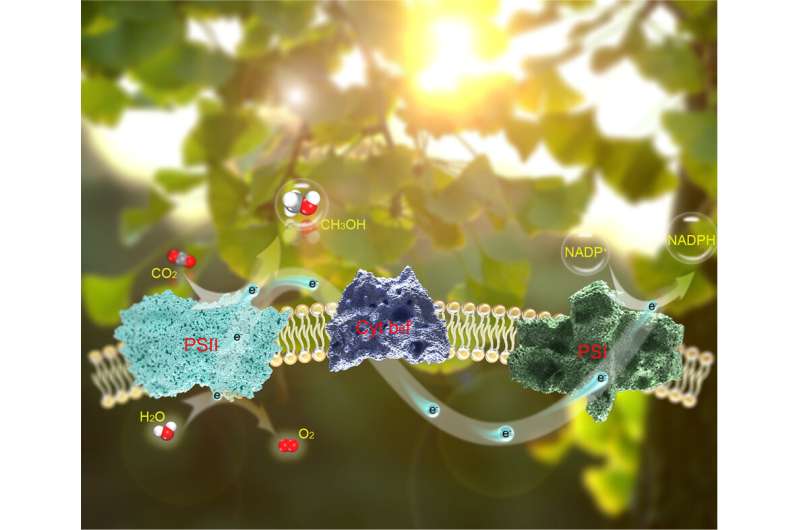Photosynthesis is the greatest natural process on Earth. It has been widely accepted that CO2 assimilation takes place in light-independent reactions, for example, through the Calvin-Benson Cycle in the stroma. Here, an unusual light-driven CO2 assimilation (into methanol) by the PSII core complex in photosynthesis was reported. The extraordinary finding is likely to be a simultaneous event along with the usual electron transfer occurring in normal light-independent assimilation. Credit: Chinese Journal of Catalysis
Photosynthesis is the greatest natural process on Earth, converting sunlight into chemical energy on a massive scale and maintaining life. There are basically two successive stages of oxygenic photosynthesis, of which the light-dependent reactions in photosystem II (PSII), and in photosystem I (PSI), enable the oxidation of H2O into molecular oxygen, and production of reducing power (NADPH and ATP), while CO2 assimilation is generally known to take place long after oxygen evolution and NADP+ reduction, via light-independent reactions in the stroma.
There is wide consensus that during light-dependent reactions CO2 (or bicarbonate) is not reduced as a substrate, but plays a unique stimulatory role in O2 evolution, namely the so-called bicarbonate effect. The role of the bicarbonate effect as well as the bicarbonate binding sites in PSII have been intensively studied since the 1970s, with some important conclusions reached thus far. However, CO2 (or bicarbonate) in PSII is thought to only play supporting roles during water oxidation, rather than being "assimilated" by PSII.
Recently, a team of researchers from Dalian University of Technology, Dalian Institute of Chemical Physics, Chinese Academy of Sciences, China, and University of Illinois at Urbana-Champaign, U.S., for the first time reported a light-driven CO2 assimilation by PSII core complex, where the formation of methanol (CH3OH), along with the oxygen evolution, is validated by in-situ mass spectrometry, gas chromatography and isotopic labeling experiments.
Such an unusual CO2 assimilation is likely to be a simultaneous event along with the usual electron transfer occurring in normal light-independent assimilation. This discovery is extraordinary and is of great significance as it may substantially modify our understanding of the mechanism of photosynthesis.
The results were published in the Chinese Journal of Catalysis.
More information: Yuehui Li et al, Light-driven CO2 assimilation by photosystem II and its relation to photosynthesis, Chinese Journal of Catalysis (2022). DOI: 10.1016/S1872-2067(22)64170-6
Provided by Chinese Academy of Sciences
























